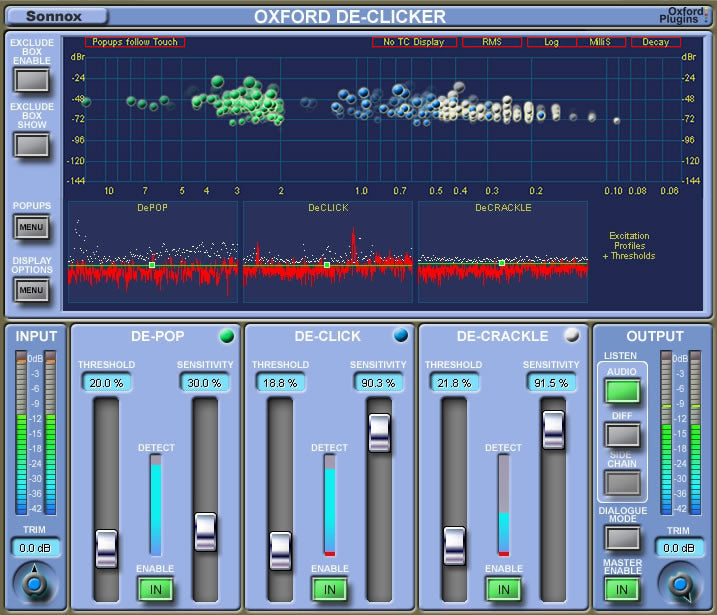
Description
Accurately and transparently remove pops, clicks and crackle using three discrete sections. Each has a threshold and sensitivity control to define the number of events that are detected and removed. The unique Events Graph shows the level and duration of each pop, click and crackle as it's detected in three separate colour-coded groups.
Sometimes there will be events detected that represent audio we want to keep rather than remove. So we built the Exclude Box to further refine the number of repaired events, and also Dialogue Mode for independent control over speech in programme.
Features:
- Three dedicated sections: DePop, DeClick and DeCrackle
- Graphic feedback of the energy/duration of detected events
- Excitation displays to help accurately set thresholds
- Exclude Box to select events that shouldn't be repaired
- Dialogue Mode: Independent settings when speech is detected
- Three audition modes:
- Listen only to removed events
- Full processed signal
- Dialogue Mode side-chain
One unique feature of the Oxford DeClicker is the Exclude Box, which enables the exclusion of detected events from the repair section. Audio restoration is always about finding the right compromise between removing unwanted noise and leaving the desired remaining audio intact without too much loss of high frequency content.
The exclude box aids this process by making exceptions to what is repaired so you don't have to battle with the sensitivity control in finding this compromise. For example, you may be happy with a piece of music and the associated repairs, except for a section with brass instruments - at which point too many high energy events are detected and corrected, resulting in diminished brightness. Similarly you may see a pop on the display that you know is part of your 'wanted audio', but other than that you are happy with your control settings. Simply draw a box around the area on the graph you wish to exclude and any events detected within that area will not be repaired (and will be coloured red).
Another example of the Oxford DeClicker's flexibility is Dialogue Mode, which enables two independent banks of controls to be set up differently for dialogue and background.
| Supported Operating Systems | macOS 10.13 High Sierra or later. Windows 10 (64-bit) or later. |
| Supported Formats | Audio Unit (AU) VST3 AAX-Native for Pro Tools 11 or later. |
| Licensing | Each Oxford plugin license includes two simultaneous activations. With an iLok account, you can authorise each activation on one of the following devices: Local Machine Install directly on your computer. iLok Device Requires an iLok2 or iLok3 USB dongle (latest drivers required). iLok Cloud Activation via iLok Cloud requires an active internet connection (only one activation can be assigned to iLok Cloud; the other must be on a Local Machine or iLok Device). |
Accurately and transparently remove pops, clicks and crackle using three discrete sections. Each has a threshold and sensitivity control to define the number of events that are detected and removed. The unique Events Graph shows the level and duration of each pop, click and crackle as it's detected in three separate colour-coded groups.
Sometimes there will be events detected that represent audio we want to keep rather than remove. So we built the Exclude Box to further refine the number of repaired events, and also Dialogue Mode for independent control over speech in programme.
Features:
- Three dedicated sections: DePop, DeClick and DeCrackle
- Graphic feedback of the energy/duration of detected events
- Excitation displays to help accurately set thresholds
- Exclude Box to select events that shouldn't be repaired
- Dialogue Mode: Independent settings when speech is detected
- Three audition modes:
- Listen only to removed events
- Full processed signal
- Dialogue Mode side-chain
One unique feature of the Oxford DeClicker is the Exclude Box, which enables the exclusion of detected events from the repair section. Audio restoration is always about finding the right compromise between removing unwanted noise and leaving the desired remaining audio intact without too much loss of high frequency content.
The exclude box aids this process by making exceptions to what is repaired so you don't have to battle with the sensitivity control in finding this compromise. For example, you may be happy with a piece of music and the associated repairs, except for a section with brass instruments - at which point too many high energy events are detected and corrected, resulting in diminished brightness. Similarly you may see a pop on the display that you know is part of your 'wanted audio', but other than that you are happy with your control settings. Simply draw a box around the area on the graph you wish to exclude and any events detected within that area will not be repaired (and will be coloured red).
Another example of the Oxford DeClicker's flexibility is Dialogue Mode, which enables two independent banks of controls to be set up differently for dialogue and background.
| Supported Operating Systems | macOS 10.13 High Sierra or later. Windows 10 (64-bit) or later. |
| Supported Formats | Audio Unit (AU) VST3 AAX-Native for Pro Tools 11 or later. |
| Licensing | Each Oxford plugin license includes two simultaneous activations. With an iLok account, you can authorise each activation on one of the following devices: Local Machine Install directly on your computer. iLok Device Requires an iLok2 or iLok3 USB dongle (latest drivers required). iLok Cloud Activation via iLok Cloud requires an active internet connection (only one activation can be assigned to iLok Cloud; the other must be on a Local Machine or iLok Device). |
Your home for all things pro audio—backed by expertise and experience. Connect with us today.
Your home for all things pro audio—backed by expertise and experience. Connect with us today.


